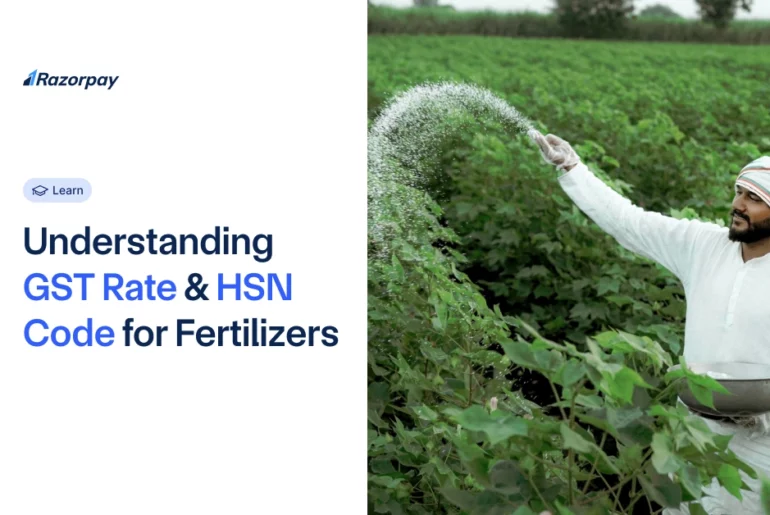Fertilizers are essential inputs for agriculture, and their cost significantly impacts farmers and agricultural businesses. In India, the Goods and Services Tax (GST) has been a game-changer for the fertilizer industry. Understanding the GST rates and HSN codes applicable to fertilizers is crucial for correct invoicing and compliance with GST laws. This article delves into the nitty-gritty of GST rates and HSN codes for fertilizers, helping you navigate the tax landscape with ease.
Table of Contents
GST Rates and HSN Codes for Fertilizers under Chapter 31
The Harmonized System of Nomenclature (HSN) is a global classification system for goods. Under this system, fertilizers fall under Chapter 31, which is further divided into various subheadings based on the type and composition of fertilizers. The fertilizer gst rate is primarily set at 5% for most products falling under this chapter. Here’s a breakdown of the key HSN codes and their corresponding GST rates:
|
HSN codes |
Description |
GST rates |
| 3101 |
Animal or vegetable fertilizers |
GST Exemption |
| 3102 |
Mineral or chemical fertilizers, nitrogenous |
5% |
| 3103 |
Mineral or chemical fertilizers, potassic |
5% |
| 3104 |
Mineral or chemical fertilizers, potassic |
5% |
| 3105 |
Mineral or chemical fertilizers containing two or three of the fertilizing elements nitrogen, phosphorus and potassium |
5%
|
Commonly used fertilizers like urea, DAP (Diammonium Phosphate), and potash fall under these HSN codes and attract a 5% GST rate. It’s important to note that the concessional 5% gst rate for fertilizer was implemented from June 28, 2017, through Notification No. 1/2017-Central Tax (Rate), considering the importance of fertilizers for the agriculture sector.
It’s important to note that goods falling under HSN 3101, which includes organic fertilizers like guano, bone meal, and oil cakes, are exempt from GST. This GST Exemption is a significant relief for farmers using organic fertilizers.
Impact of GST on the Fertilizer Industry
The introduction of GST has had a notable impact on the fertilizer industry. Prior to 1st July 2017, fertilizers attracted Value Added Tax (VAT), which varied from state to state. The GST council decided to reduce the tax burden on farmers by exempting fertilizers falling under HSN 3101 and reducing GST to 5% on other fertilizers.
This change in GST rates has brought uniformity in fertilizer taxation across India. It has also eased the cost burden on farmers, as the reduced GST rate on fertilizers means lower prices for these essential agricultural inputs.
Explanations on HSN Codes and Fertilizers’ Categories
HSN (Harmonized System of Nomenclature) codes play a vital role in classifying goods for taxation purposes. For fertilizers, accurate HSN codes are essential to ensure proper GST compliance and avoid filing errors or penalties. Here’s a closer look at the classification of fertilizers under Chapter 31:
|
HSC Code |
Fertilizer Type |
| 3101 |
Organic fertilizers (e.g., animal waste, compost) |
|
3102 to 3104 |
Chemical fertilizers (nitrogenous, phosphatic, potassic) |
| 3105 |
Fertilizers containing multiple nutrients (N, P, K) |
|
3101 or 3105 (depending on composition) |
Bio-fertilizers and other fertilizer products |
Using the correct fertilizer hsn code and gst rate is crucial for accurate invoicing and GST returns filing. Businesses dealing with fertilizers must stay updated with any changes in HSN codes or GST rates to ensure compliance.
Related Read: GST on Plants: Tax Rates, Exemptions & Compliance Guide
Conclusion
Understanding the GST rates and HSN codes for fertilizers is vital for farmers, agricultural businesses, and fertilizer manufacturers. The reduced GST rate for fertilizers has brought relief to the farming community, while the HSN code classification has brought clarity and uniformity in fertilizer taxation.
By using the correct HSN codes and applying the appropriate GST rates, you can ensure compliance with GST laws and avoid any legal complications. Stay informed about the latest updates in GST regulations to make the most of the tax benefits available for fertilizers.
Frequently Asked Questions (FAQs)
1. What happens if the wrong HSN code is used for fertilizers?
Using the wrong HSN code for fertilizers can lead to incorrect GST filing, potential penalties, and issues with claiming input tax credit. It’s crucial to use the correct HSN code to avoid such complications.
2. Why do fertilizers have different GST rates?
Fertilizers have different GST rates based on their type and composition. Organic fertilizers under HSN 3101 are exempt from GST, while mineral and chemical fertilizers under HSN 3102 to 3105 attract a 5% GST rate.
3. Are imported fertilizers subject to the same GST rates as domestic ones?
Yes, imported fertilizers are subject to the same GST rates as domestic ones, based on their HSN classification.
3. Do I need to file GST on the sale of fertilizers if I’m a small farmer?
If your annual turnover is below the GST threshold (currently .₹40 lakhs), you are not required to register under GST or file GST returns on the sale of fertilizers.
4. Is GST applicable to fertilizers sold in bulk or retail?
GST is applicable to fertilizers irrespective of whether they are sold in bulk or retail. The GST rate depends on the HSN classification of the fertilizer.
5. How do I find the correct HSN code for fertilizers?
You can find the correct HSN code for fertilizers by referring to the HSN classification under Chapter 31. The GST tariff schedule provides a detailed list of HSN codes for different types of fertilizers.
6. Are bio-fertilizers taxed differently under GST?
Bio-fertilizers containing living micro-organisms like Rhizobium and Azotobactor fall under HSN 3101 and are exempt from GST.
7. How does GST apply to government-subsidized fertilizers?
Government-subsidized fertilizers are subject to the same GST rates as non-subsidized ones, based on their HSN classification. However, the subsidy component is generally not taxable under GST.



